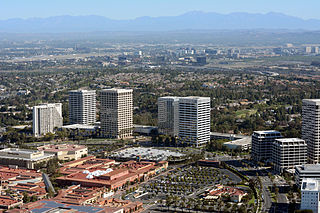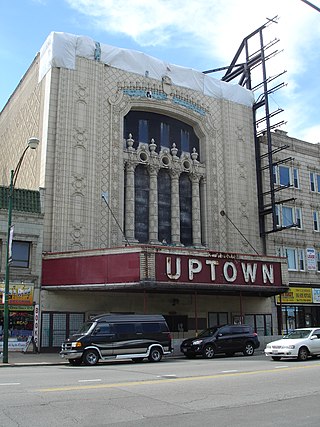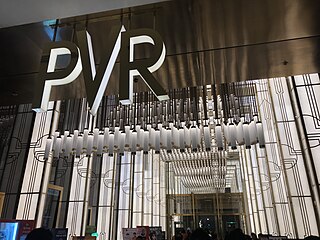
A movie theater, cinema, or cinema hall, also known as a movie house, picture house, picture theater or simply theater, is a business that contains auditoria for viewing films for public entertainment. Most are commercial operations catering to the general public, who attend by purchasing tickets.

AMC Entertainment Holdings, Inc. is an American movie theater chain founded in Kansas City, Missouri, and now headquartered in Leawood, Kansas. It is the largest movie theater chain in the world. Founded in 1920, AMC has the largest share of the U.S. theater market ahead of Regal and Cinemark Theatres.

Fashion Island is an outdoor regional shopping mall in Newport Beach, California. Opened in 1967 by The Irvine Company as the anchor to their master-planned Newport Center district, Fashion Island is anchored by Bloomingdale's, Macy's, Neiman Marcus, and Nordstrom.

The Irvine Spectrum Center is a open-air lifestyle center developed by the Irvine Company, located in the Irvine Spectrum district on the southeast edge of Irvine, California. The center features Nordstrom and Target department stores, a ferris wheel, and a Regal Cinemas 21-screen movie theater. Built over a 10-year period, the first phase of the center opened in 1995 and the second phase followed in 1998. The third phase was completed in 2002. The fourth and fifth phases were built and completed between 2005 and 2006. The center was used for establishing shots of the fictional "Mall of Miami" in the Disney Channel television series Austin and Ally.

Regal Cinemas is an American movie theater chain headquartered in Knoxville, Tennessee. A division of Cineworld, Regal operates the second-largest theater circuit in the United States, with 6,853 screens in 511 theaters as of December 31, 2021. The three main theatre brands operated by Regal Entertainment Group are Regal Cinemas, Edwards Theatres, and United Artists Theatres.

A movie palace is a large, elaborately decorated movie theater built from the 1910s to the 1940s. The late 1920s saw the peak of the movie palace, with hundreds opening every year between 1925 and 1930. With the advent of television, movie attendance dropped, while the rising popularity of large multiplex chains in the 1980s and 1990s signaled the obsolescence of single-screen theaters. Many movie palaces were razed or converted into multiple-screen venues or performing arts centers, though some have undergone restoration and reopened to the public as historic buildings.

Muvico Theaters was a movie theater chain headquartered in Fort Lauderdale, Florida. Muvico had seven complexes in Florida, one in the Chicago metropolitan area (Rosemont), and one in Thousand Oaks, California. Muvico's theaters were known for the use of decorative themes at several theaters, such as the Egyptian, 1950s drive-in, French opera house, Mediterranean palace, and 1920s grand movie palace themes.
Landmark Theatres is a movie theatre chain founded in 1974 in the United States. It was formerly dedicated to exhibiting and marketing independent and foreign films. Landmark consists of 34 theatres with 176 screens in 24 markets. It is known for both its historic and newer, more modern theatres. Helmed by its President Kevin Holloway, Landmark Theatres is part of Cohen Media Group.

Carmike Cinemas was a motion picture exhibitor headquartered in Columbus, Georgia. As of March 2016, the company had 276 theaters with 2,954 screens in 41 states, and was the fourth largest movie theater chain in the United States. The company billed itself as "America's Hometown Theatre" and Carmike theaters were largely positioned in rural or suburban areas with populations under 200,000. The company's theaters operated under various names and generally had a name followed by the number of auditoriums at that location; for example, "Carmike 15".

Cinemex is a Mexican chain of cinemas. It operates multiplexes in cities such as Mexico City, Guadalajara, Monterrey, Toluca, Cd. Juarez, Leon, Tijuana, Mexicali, Puebla and other Mexican cities.

The Kinepolis Group is a Belgian cinema chain with 110 theaters in Europe and North America. It is Europe’s third-largest cinema chain.

PVR INOX Ltd, formerly known as PVR Cinemas, is an Indian multiplex chain based in Mumbai. It was formed as a result of the merger between PVR Cinemas and INOX Leisure Multiplex. PVR pioneered the multiplex revolution in India by establishing the first multiplex cinema in 1997 at Saket, New Delhi. In 2022, PVR Cinemas achieved the milestone of completing 25 years in the business. As of December 2023, PVR Inox has 1747 screens across 359 properties in 114 cities.

A multiplex is a movie theater complex with multiple screens or auditoriums within a single complex. They are usually housed in a specially designed building. Sometimes, an existing venue undergoes a renovation where the existing auditoriums are split into smaller ones, or more auditoriums are added in an extension or expansion of the building. The largest of these complexes can sit thousands of people and are sometimes referred to as a megaplex.
Cinépolis is a Mexican and international movie theater chain. Its name means City of Cinema and its slogan is La Capital del Cine.
ArcLight Cinemas was an American movie theater chain that operated from 2002 to 2021. It was owned by The Decurion Corporation, which was also the parent company of Pacific Theatres. The ArcLight chain opened in 2002 as a single theater, the ArcLight Hollywood in Hollywood, Los Angeles, and later expanded to eleven locations in California, Massachusetts, Maryland, and Illinois.

CJ CGV is the largest multiplex cinema chain in South Korea and also has branches in China, Indonesia, Myanmar, Turkey, Vietnam, and the United States. The fifth largest multiplex theater company in the world, CJ CGV currently operates 3,412 screens at 455 locations in seven countries, including 1,111 screens at 149 locations in South Korea. CGV takes its name from the first letters of the joint venture partners at the time of launching; CJ, Golden Harvest, and Village Roadshow.

Megaplex Theatres is a cinema chain based in Sandy, Utah. It was founded in 1999 by the late Larry H. Miller, who was then the owner of the Utah Jazz; currently it is owned by the Larry H. Miller Company. As of 2023, Megaplex Theatres operates 15 locations in Utah and Nevada, and it has plans to expand into Idaho.

4DX is a 4D film presentation system developed by CJ 4DPlex, a subsidiary of South Korean cinema chain CJ CGV. It allows films to be augmented with various practical effects, including motion-seats, wind, strobelights, simulated snow, and scents. First debuted in 2009, it presents films in both stereoscopic 3-D and monoscopic 2-D formats.

Act III Theatres was an American company that owned movie theater multiplexes and screens principally located in the U.S. states of Texas, Oregon and Washington. The company was in business from 1986 to 1997, when it was sold to Kohlberg Kravis Roberts (KKR). Television producer Norman Lear owned a controlling stake in Act III Theatres through his company Act III Communications. At the time of sale in 1997, Act III Theaters consisted of 124 multiplex theaters operating 793 screens located primarily in San Antonio and Austin, Texas and Portland, Oregon, and was the tenth-largest chain of cinemas in the United States.
















